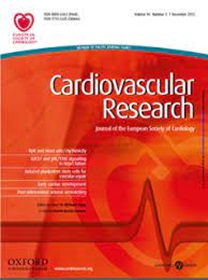Cardioprotective effect of 19,20-epoxydocosapentaenoic acid (19,20-EDP) in ischemic injury involves direct activation of mitochondrial sirtuin 3
IF 10.2
1区 医学
Q1 CARDIAC & CARDIOVASCULAR SYSTEMS
引用次数: 0
Abstract
Aims Although current clinical therapies following myocardial infarction have improved patient outcomes, morbidity, and mortality rates secondary to ischemic and ischemia reperfusion (IR) injury remains high. Maintaining mitochondrial quality is essential to limit myocardial damage following cardiac ischemia and IR injury. The mitochondrial deacetylase sirtuin 3 (SIRT3) plays a pivotal role in regulating mitochondrial function and cardiac energy metabolism. In the current study, we hypothesize that 19,20-epoxydocosapentaenoic acid (19,20-EDP) attenuates cardiac IR injury via stimulating mitochondrial SIRT3. Methods and Results Ex vivo models of isolated heart perfusions were performed in C57BL/6 mice to assess the effect of 19,20-EDP on cardiac function and energy metabolism following IR injury. In vivo permanent occlusion of the left anterior descending coronary artery (LAD) was performed to induce myocardial infarction (MI), mice were administered 19,20-EDP with or without the SIRT3 selective inhibitor 3-TYP. Mitochondrial SIRT3 targets and respiration were assessed in human left ventricular (LV) tissues obtained from individuals with ischemic heart disease (IHD) and compared to non-failing controls (NFC). Binding affinity of 19,20-EDP to human SIRT3 was assessed using molecular modeling and fluorescence thermal shift assay. Results demonstrated hearts treated with 19,20-EDP had improved post-ischemic cardiac function, better glucose oxidation rates and enhanced cardiac efficiency. The cardioprotective effects were associated with enhanced mitochondrial SIRT3 activity. Interestingly, treatment with 19,20-EDP markedly improved mitochondrial respiration and SIRT3 activity in human left ventricle (LV) fibers with IHD compared to NFC. Moreover, 19,20-EDP was found to bind to the human SIRT3 protein enhancing the NAD+ -complex stabilization leading to improved SIRT3 activity. Importantly, the beneficial effects of 19,20-EDP were abolished by SIRT3 inhibition or using the S149A mutant SIRT3. Conclusion These data demonstrate that 19,20-EDP-mediated cardioprotective mechanisms against ischemia and IR injury involve mitochondrial SIRT3, resulting in improved cardiac efficiency.19,20-环氧二十二碳五烯酸(19,20- edp)在缺血性损伤中的心脏保护作用涉及线粒体sirtuin 3的直接激活
虽然目前的临床治疗方法改善了心肌梗死患者的预后,但缺血性和缺血再灌注(IR)损伤继发的发病率和死亡率仍然很高。维持线粒体质量对于限制心肌缺血和IR损伤后的心肌损伤至关重要。线粒体去乙酰化酶sirtuin 3 (SIRT3)在调节线粒体功能和心脏能量代谢中起关键作用。在目前的研究中,我们假设19,20-环氧多碳五烯酸(19,20- edp)通过刺激线粒体SIRT3来减轻心脏IR损伤。方法与结果采用离体心脏灌注C57BL/6小鼠模型,观察19,20- edp对IR损伤后心功能和能量代谢的影响。在体内永久性阻断左冠状动脉前降支(LAD)以诱导心肌梗死(MI),小鼠分别给予19,20- edp(含或不含SIRT3选择性抑制剂3-TYP)。在从缺血性心脏病(IHD)患者获得的人左心室(LV)组织中评估线粒体SIRT3靶点和呼吸,并与非衰竭对照组(NFC)进行比较。利用分子建模和荧光热移法评估19,20- edp与人SIRT3的结合亲和力。结果表明,19,20- edp治疗心脏缺血后心功能改善,葡萄糖氧化率提高,心脏效率提高。心脏保护作用与线粒体SIRT3活性增强有关。有趣的是,与NFC相比,19,20- edp治疗可显著改善IHD患者左心室(LV)纤维的线粒体呼吸和SIRT3活性。此外,19,20- edp被发现与人类SIRT3蛋白结合,增强NAD+复合物的稳定性,从而提高SIRT3活性。重要的是,19,20- edp的有益作用被SIRT3抑制或使用S149A突变体SIRT3所消除。结论19,20- edp介导的抗缺血和IR损伤的心脏保护机制涉及线粒体SIRT3,从而提高心脏效率。
本文章由计算机程序翻译,如有差异,请以英文原文为准。
求助全文
约1分钟内获得全文
求助全文
来源期刊

Cardiovascular Research
医学-心血管系统
CiteScore
21.50
自引率
3.70%
发文量
547
审稿时长
1 months
期刊介绍:
Cardiovascular Research
Journal Overview:
International journal of the European Society of Cardiology
Focuses on basic and translational research in cardiology and cardiovascular biology
Aims to enhance insight into cardiovascular disease mechanisms and innovation prospects
Submission Criteria:
Welcomes papers covering molecular, sub-cellular, cellular, organ, and organism levels
Accepts clinical proof-of-concept and translational studies
Manuscripts expected to provide significant contribution to cardiovascular biology and diseases
 求助内容:
求助内容: 应助结果提醒方式:
应助结果提醒方式:


